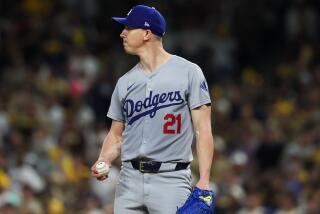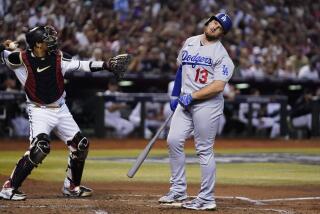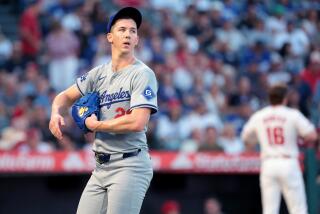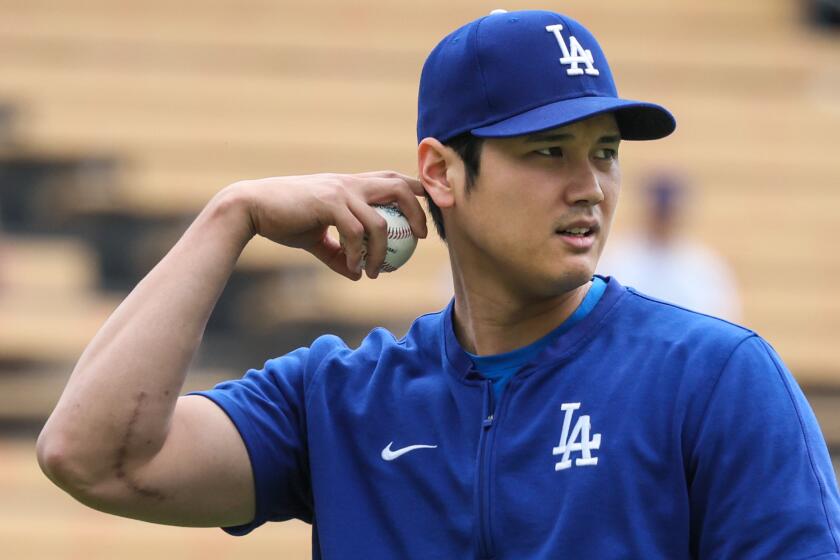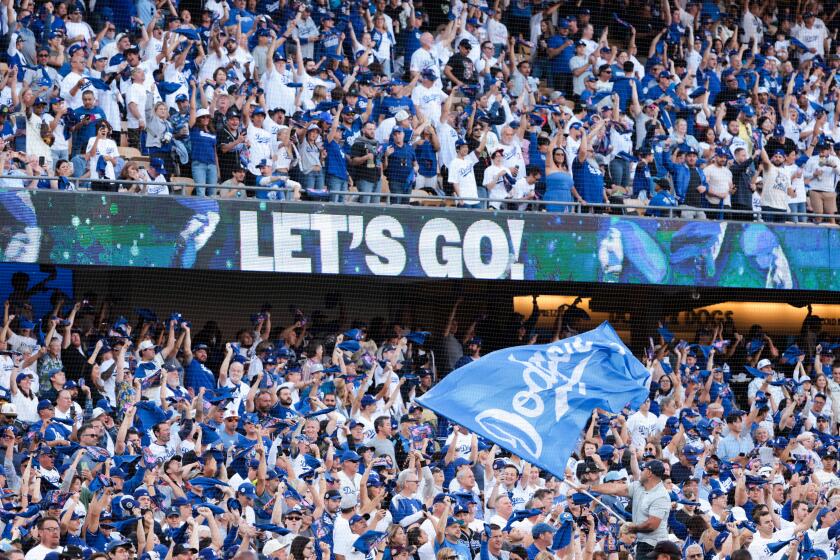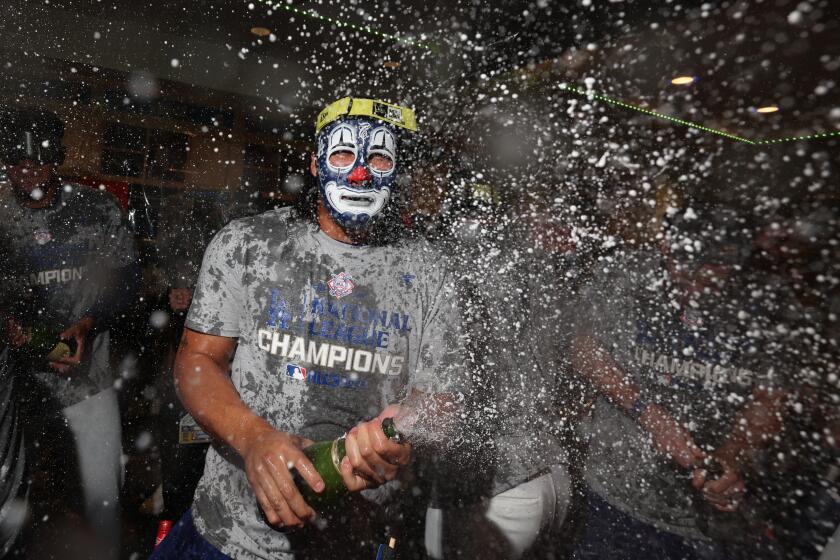Padres try to challenge Dodgers with a budget-conscious pitching rotation
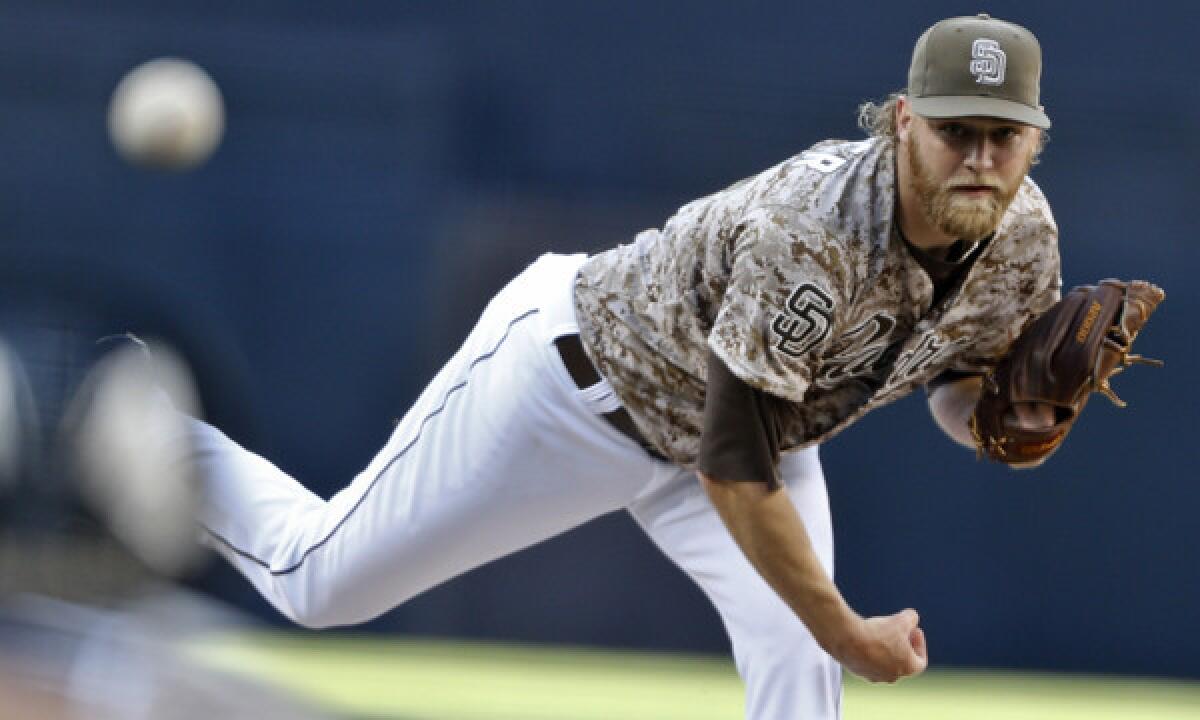
San Diego Padres starter Andrew Cashner delivers a pitch during Sunday’s win over the Dodgers. Cashner isn’t a household name, but he performed well against the high-priced Dodgers lineup in the Padres’ season opener.
The Dodgers have the best starting rotation money can buy.
Best pitcher in baseball? Keep him, for $215 million. Best pitcher in free agency, in the first off-season under new ownership? Buy him, for $147 million. Best pitcher to come out of South Korea? Buy him too, for $62 million.
The San Diego Padres have to compete against the Dodgers in the National League West. They have to assemble a starting rotation too, without a wallet stuffed with blank checks.
“It requires some imagination,” Padres General Manager Josh Byrnes said.
As the Dodgers and Padres resume their series at Petco Park on Tuesday, the contrast in the resources available to the two franchises could not be more stark.
The Dodgers hand the ball to Zack Greinke, who is getting paid $24 million this season. The Padres’ five-man starting rotation is getting $14 million.
Greinke is good, but he is not the best the Dodgers have to offer. The Padres dodged Clayton Kershaw, the $215-million man and the reigning National League Cy Young Award winner, who was scratched from this series because of an inflamed muscle.
The Padres concede nothing to the Dodgers regarding the merits of the respective rotations, except that the Dodgers have the bigger salaries, the track records and the more glamorous names.
“We like our names,” Padres Manager Bud Black said.
In an era where baseball’s less-prosperous teams preach the gospel of going young and building from within, the Padres’ rotation offers a creative alternative.
The Padres’ Eric Stults, 34, is older than any of the Dodgers’ starting five. And, had Padres’ free-agent signee Josh Johnson not started the season on the disabled list, the average age of each team’s rotation would have been the same: 29.
Stults, a Dodgers castoff who had to go to Japan to reboot his career, was claimed on waivers by the Padres two years ago.
San Diego acquired its other four starters in trade. Andrew Cashner, their opening-night starter, came from the Chicago Cubs, where he was an inexperienced middle reliever. The Padres got him in a prospect-for-prospect deal, for first baseman Anthony Rizzo. The remaining three starters — Ian Kennedy, Tyson Ross and Robbie Erlin — were acquired from contenders, in exchange for bench or bullpen help.
None was, or is, a sure thing.
“Sometimes you have to buy low and know it might not be a plug-and-play scenario,” Byrnes said. “We have to pick our spots and take some upside. It’s no different for us than how you approach the draft.”
Johnson had the lowest earned-run average in the NL in 2010, but he has had one healthy season since then, and now he is injured again. Kennedy won 21 games in 2011, but his earned-run average jumped from 2.88 three years ago to 4.91 last year.
“Guys are available for a reason,” Byrnes said.
The guys the Padres are most excited about are Cashner and Ross, whose power arms are at the head of the rotation. With spacious grounds and a resident marine layer, Petco Park so favors pitching that the Padres have had little trouble persuading veteran fly-ball pitchers to sign with the team for a year, boost their statistics and seek fortune elsewhere.
That did little to help the Padres when they ventured outside the state. The Padres’ starters ranked 12th in the league in ERA last year and 13th two years ago, even with the Petco edge.
“We don’t want to just have good reclamation pitching,” Byrnes said. “We want to have dominant pitching. We want to have power arms who can dominate in any venue.”
Cashner, 27, was 10-9 with a 3.09 ERA last season, his first as a major league starter. In the second half, he was 5-4 with a 2.14 ERA and had 61 strikeouts in 75 innings.
Ross, 26, is scheduled to start Wednesday against the Dodgers. He was 3-4 with a 2.93 ERA after the Padres put him in the rotation for good in July, with 85 strikeouts in 80 innings.
“On a given night, they can match up with any pitcher in baseball,” Black said. “The only thing they haven’t done is pass the test of time. You look at Kershaw and [St. Louis Cardinals ace Adam] Wainwright, those guys have passed the test of time.
“The first two or three years of Kershaw were a little uneven. Look at him now. That’s what makes him who he is.”
Stults saw that firsthand, in his final years in the Dodgers organization. It takes time for power pitchers to learn that they can win without maximum power, that a 92-mph fastball thrown with precision is preferable to a 95-mph fastball that looks better to the guy operating the radar gun than to the guy calling balls and strikes.
“I’ve seen Andrew take that step that Kershaw did after a year or two in the big leagues,” Stults said. “Same thing with Tyson.
“When you have stuff like those two guys, you don’t need to be perfect. When those guys are around the plate, they’re as good as anybody.”
Byrnes said the excellence of the Dodgers rotation challenges the other clubs in the NL West to improve their rotations or be left behind.
“If that’s the standard, we just need to be within range,” Byrnes said.
Ross came from Oakland, where the Athletics worked wonders with a similarly unheralded rotation. He said the Padres rotation is capable of matching up with the Dodgers rotation.
Stults was even more confident in his assessment of the starting rotation, albeit with the disclaimers of a veteran.
“If guys stay within themselves and don’t try to do too much and focus on executing pitches,” Stults said, “we can stick with any team in the American League or National League.”
Twitter: @BillShaikin
More to Read
Are you a true-blue fan?
Get our Dodgers Dugout newsletter for insights, news and much more.
You may occasionally receive promotional content from the Los Angeles Times.
